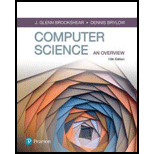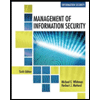
Computer Science: An Overview (13th Edition) (What's New in Computer Science)
13th Edition
ISBN: 9780134875460
Author: Glenn Brookshear, Dennis Brylow
Publisher: PEARSON
expand_more
expand_more
format_list_bulleted
Question
Chapter 6.6, Problem 2QE
Program Plan Intro
Mutually exclusive access of shared data:
The data that have access to only one thread at a time is Mutual exclusion access of shared data. It helps to solve various thread related problems, such as if two threads working concurrently want to add or subtract some value, it is necessary to give them chance of doing operation one after the other.
Expert Solution & Answer
Want to see the full answer?
Check out a sample textbook solution
Students have asked these similar questions
Question 1 Generate a random sample of standard lognormal data (rlnorm()) for sample size n = 100. Construct histogram estimates of density for this sample using Sturges’ Rule, Scott’s Normal Reference Rule, and the FD Rule. Question 2 Construct a frequency polygon density estimate for the sample in Question 1, using bin width determined by Sturges’ Rule.
Generate a random sample of standard lognormal data (rlnorm()) for sample size n = 100. Construct histogram estimates of density for this sample using Sturges’ Rule, Scott’s Normal Reference Rule, and the FD Rule.
Can I get help with this case please, thank you
Chapter 6 Solutions
Computer Science: An Overview (13th Edition) (What's New in Computer Science)
Ch. 6.1 - In what sense is a program in a third-generation...Ch. 6.1 - We can summarize the imperative programming...Ch. 6.1 - Prob. 4QECh. 6.2 - Why is the use of a constant considered better...Ch. 6.2 - Prob. 2QECh. 6.2 - Prob. 3QECh. 6.2 - Identity some common control structures found in...Ch. 6.2 - What is the difference between an array and an...Ch. 6.3 - Prob. 1QECh. 6.3 - Prob. 2QE
Ch. 6.3 - Why do many programming languages implement I/O...Ch. 6.3 - Prob. 4QECh. 6.3 - Prob. 5QECh. 6.4 - Prob. 1QECh. 6.4 - What is a symbol table?Ch. 6.4 - What is the difference between a terminal and a...Ch. 6.4 - Prob. 4QECh. 6.4 - Prob. 5QECh. 6.4 - Prob. 6QECh. 6.5 - What is the difference between an object and a...Ch. 6.5 - Prob. 2QECh. 6.5 - Suppose the classes PartTimeEmployee and...Ch. 6.5 - What is a constructor?Ch. 6.5 - Why are some items within a class designated as...Ch. 6.6 - Prob. 1QECh. 6.6 - Prob. 2QECh. 6.6 - Prob. 3QECh. 6.7 - Prob. 2QECh. 6.7 - Prob. 3QECh. 6.7 - Prob. 4QECh. 6 - Prob. 1CRPCh. 6 - Translate the following Python program into the...Ch. 6 - Prob. 3CRPCh. 6 - Why was it necessary to identify the type of data...Ch. 6 - Prob. 6CRPCh. 6 - Suppose the function f expects two numeric values...Ch. 6 - Suppose f is a function that returns the result of...Ch. 6 - Prob. 9CRPCh. 6 - Summarize the distinction between a machine...Ch. 6 - John Programmer argues that the ability to declare...Ch. 6 - Summarize the distinction between declarative...Ch. 6 - Explain the differences between a literal, a...Ch. 6 - a. What is operator precedence? b. Depending on...Ch. 6 - Prob. 16CRPCh. 6 - What is the difference between the meaning of the...Ch. 6 - Draw a flowchart representing the structure...Ch. 6 - Prob. 19CRPCh. 6 - Prob. 20CRPCh. 6 - Draw a flowchart representing the structure...Ch. 6 - Rewrite the following program segment using a...Ch. 6 - Summarize the following rats-nest routine with a...Ch. 6 - Prob. 24CRPCh. 6 - Prob. 25CRPCh. 6 - Suppose the variable X in a program was declared...Ch. 6 - Prob. 27CRPCh. 6 - Why would a large array probably not be passed to...Ch. 6 - Sometimes an actual parameter is passed to a...Ch. 6 - Prob. 32CRPCh. 6 - What ambiguity exists in the statement X = 3 + 2 ...Ch. 6 - Suppose a small company has five employees and is...Ch. 6 - Prob. 35CRPCh. 6 - Prob. 36CRPCh. 6 - Prob. 37CRPCh. 6 - Prob. 38CRPCh. 6 - Prob. 39CRPCh. 6 - Design a set of syntax diagrams that describes the...Ch. 6 - Prob. 41CRPCh. 6 - Prob. 42CRPCh. 6 - Add syntax diagrams to those in Question 5 of...Ch. 6 - Prob. 44CRPCh. 6 - What code optimization could be performed by a...Ch. 6 - Simplify the following program segment Y = 5 if (Y...Ch. 6 - Simplify the following program segment while (X !=...Ch. 6 - In an object-oriented programming environment, how...Ch. 6 - Describe how inheritance might be used to develop...Ch. 6 - What is the difference between the public and...Ch. 6 - a. Give an example of a situation in which an...Ch. 6 - Describe some objects that might be found in a...Ch. 6 - Prob. 53CRPCh. 6 - Prob. 54CRPCh. 6 - Prob. 55CRPCh. 6 - Prob. 56CRPCh. 6 - Prob. 57CRPCh. 6 - Prob. 58CRPCh. 6 - Prob. 59CRPCh. 6 - In general copyright laws support ownership rights...Ch. 6 - By using a high-level programming language, a...Ch. 6 - Prob. 3SICh. 6 - Prob. 4SICh. 6 - Prob. 5SICh. 6 - Suppose an amateur programmer writes a program for...Ch. 6 - Prob. 7SI
Knowledge Booster
Similar questions
- I need help to solve the following, thank youarrow_forwardreminder it an exercice not a grading work GETTING STARTED Open the file SC_EX19_EOM2-1_FirstLastNamexlsx, available for download from the SAM website. Save the file as SC_EX19_EOM2-1_FirstLastNamexlsx by changing the “1” to a “2”. If you do not see the .xlsx file extension in the Save As dialog box, do not type it. The program will add the file extension for you automatically. With the file SC_EX19_EOM2-1_FirstLastNamexlsx still open, ensure that your first and last name is displayed in cell B6 of the Documentation sheet. If cell B6 does not display your name, delete the file and download a new copy from the SAM website. Brad Kauffman is the senior director of projects for Rivera Engineering in Miami, Florida. The company performs engineering projects for public utilities and energy companies. Brad has started to create an Excel workbook to track estimated and actual hours and billing amounts for each project. He asks you to format the workbook to make the…arrow_forwardNeed help completing this algorithm here in coding! 2arrow_forward
- In the diagram, there is a green arrow pointing from Input C (complete data) to Transformer Encoder S_B, which I don’t understand. The teacher model is trained on full data, but S_B should instead receive missing data—this arrow should not point there. Please verify and recreate the diagram to fix this issue. Additionally, the newly created diagram should meet the same clarity standards as the second diagram (Proposed MSCATN). Finally provide the output image of the diagram in image format .arrow_forwardPlease provide me with the output image of both of them . below are the diagrams code make sure to update the code and mentionned clearly each section also the digram should be clearly describe like in the attached image. please do not provide the same answer like in other question . I repost this question because it does not satisfy the requirment I need in terms of clarifty the output of both code are not very well details I have two diagram : first diagram code graph LR subgraph Teacher Model (Pretrained) Input_Teacher[Input C (Complete Data)] --> Teacher_Encoder[Transformer Encoder T] Teacher_Encoder --> Teacher_Prediction[Teacher Prediction y_T] Teacher_Encoder --> Teacher_Features[Internal Features F_T] end subgraph Student_A_Model[Student Model A (Handles Missing Values)] Input_Student_A[Input M (Data with Missing Values)] --> Student_A_Encoder[Transformer Encoder E_A] Student_A_Encoder --> Student_A_Prediction[Student A Prediction y_A] Student_A_Encoder…arrow_forwardWhy I need ?arrow_forward
arrow_back_ios
SEE MORE QUESTIONS
arrow_forward_ios
Recommended textbooks for you
 Management Of Information SecurityComputer ScienceISBN:9781337405713Author:WHITMAN, Michael.Publisher:Cengage Learning,
Management Of Information SecurityComputer ScienceISBN:9781337405713Author:WHITMAN, Michael.Publisher:Cengage Learning, Enhanced Discovering Computers 2017 (Shelly Cashm...Computer ScienceISBN:9781305657458Author:Misty E. Vermaat, Susan L. Sebok, Steven M. Freund, Mark Frydenberg, Jennifer T. CampbellPublisher:Cengage Learning
Enhanced Discovering Computers 2017 (Shelly Cashm...Computer ScienceISBN:9781305657458Author:Misty E. Vermaat, Susan L. Sebok, Steven M. Freund, Mark Frydenberg, Jennifer T. CampbellPublisher:Cengage Learning Principles of Information Systems (MindTap Course...Computer ScienceISBN:9781285867168Author:Ralph Stair, George ReynoldsPublisher:Cengage Learning
Principles of Information Systems (MindTap Course...Computer ScienceISBN:9781285867168Author:Ralph Stair, George ReynoldsPublisher:Cengage Learning Systems ArchitectureComputer ScienceISBN:9781305080195Author:Stephen D. BurdPublisher:Cengage Learning
Systems ArchitectureComputer ScienceISBN:9781305080195Author:Stephen D. BurdPublisher:Cengage Learning


Management Of Information Security
Computer Science
ISBN:9781337405713
Author:WHITMAN, Michael.
Publisher:Cengage Learning,

Enhanced Discovering Computers 2017 (Shelly Cashm...
Computer Science
ISBN:9781305657458
Author:Misty E. Vermaat, Susan L. Sebok, Steven M. Freund, Mark Frydenberg, Jennifer T. Campbell
Publisher:Cengage Learning

Principles of Information Systems (MindTap Course...
Computer Science
ISBN:9781285867168
Author:Ralph Stair, George Reynolds
Publisher:Cengage Learning


Systems Architecture
Computer Science
ISBN:9781305080195
Author:Stephen D. Burd
Publisher:Cengage Learning